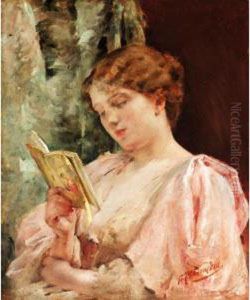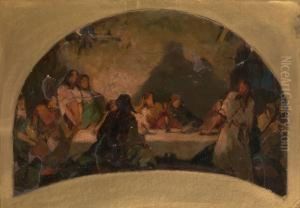Paul A. Svedomsky Paintings
Paul Alexandrovich Svedomsky was a Russian painter known for his historical and religious themed works. Born on July 27, 1849, in St. Petersburg, Russia, Svedomsky developed an interest in art at an early age. His father, Alexander Svedomsky, was also a painter, which provided young Paul with an artistic environment from the start. Svedomsky received his early education at the Imperial Academy of Arts in St. Petersburg, where he excelled and was awarded several medals for his work.
Svedomsky's art was deeply influenced by the academicism of the 19th century, characterized by a rigorous adherence to classical standards, detailed technique, and often grandiose subjects drawn from history, mythology, and religion. He was particularly known for his meticulous attention to historical accuracy in his paintings, as well as his ability to capture the essence of the religious stories he depicted.
In 1876, Svedomsky left Russia to continue his studies abroad, like many artists of his time. He traveled to Rome, where he worked and studied the masterpieces of Renaissance art. The Italian influence is evident in many of his works, which often reflect the warm palette and compositional techniques of the Italian masters. During his time in Italy, Svedomsky collaborated with his brother, the artist Alexander Svedomsky, on a series of paintings.
Svedomsky returned to Russia in the early 1880s and continued to work on religious subjects. He received commissions for church decorations and contributed to the restoration of frescoes in historical buildings. His work was well-received, and he became a respected member of the Russian art community. In addition to his religious and historical paintings, Svedomsky also produced portraits, genre scenes, and landscapes.
Paul Alexandrovich Svedomsky passed away on May 29, 1904. Although he is not as widely known today as some of his contemporaries, his work remains an important part of the 19th-century Russian art canon. His paintings can be found in various museums and private collections, offering a glimpse into the rich tapestry of Russian history and the religious sentiment of the era.

